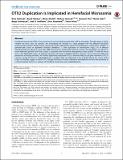OTX2 Duplication Is Implicated in Hemifacial Microsomia
Author(s)
Zielinski, Dina; Markus, Barak; Sheikh, Mona; Gymrek, Melissa A.; Chu, Clement; Zaks, Marta; Srinivasan, Balaji; Hoffman, Jodi D.; Aizenbud, Dror; Erlich, Yaniv; ... Show more Show less
DownloadZielinski-2014-OTX2 Duplication Is.pdf (685.2Kb)
PUBLISHER_CC
Publisher with Creative Commons License
Creative Commons Attribution
Terms of use
Metadata
Show full item recordAbstract
Hemifacial microsomia (HFM) is the second most common facial anomaly after cleft lip and palate. The phenotype is highly variable and most cases are sporadic. We investigated the disorder in a large pedigree with five affected individuals spanning eight meioses. Whole-exome sequencing results indicated the absence of a pathogenic coding point mutation. A genome-wide survey of segmental variations identified a 1.3 Mb duplication of chromosome 14q22.3 in all affected individuals that was absent in more than 1000 chromosomes of ethnically matched controls. The duplication was absent in seven additional sporadic HFM cases, which is consistent with the known heterogeneity of the disorder. To find the critical gene in the duplicated region, we analyzed signatures of human craniofacial disease networks, mouse expression data, and predictions of dosage sensitivity. All of these approaches implicated OTX2 as the most likely causal gene. Moreover, OTX2 is a known oncogenic driver in medulloblastoma, a condition that was diagnosed in the proband during the course of the study. Our findings suggest a role for OTX2 dosage sensitivity in human craniofacial development and raise the possibility of a shared etiology between a subtype of hemifacial microsomia and medulloblastoma.
Date issued
2014-05Department
Harvard University--MIT Division of Health Sciences and Technology; Whitehead Institute for Biomedical ResearchJournal
PLoS ONE
Publisher
Public Library of Science
Citation
Zielinski, Dina, Barak Markus, Mona Sheikh, Melissa Gymrek, Clement Chu, Marta Zaks, Balaji Srinivasan, Jodi D. Hoffman, Dror Aizenbud, and Yaniv Erlich. “OTX2 Duplication Is Implicated in Hemifacial Microsomia.” Edited by Yann Herault. PLoS ONE 9, no. 5 (May 9, 2014): e96788.
Version: Final published version
ISSN
1932-6203